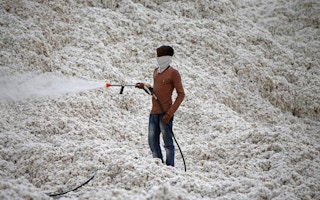A top cotton producing state in India is to start mapping its entire supply chain as part of a unique collaboration with the International Labour Organisation (ILO) to weed out child labour and slavery from its fields and factories.
The southern state of Telangana will this month begin a three-year project with the UN labour agency to map its cotton growing farms and spinning mills to ensure its main industry is ethical, senior labour officials said on Monday.
“This is for the first time in India that an integrated approach to identify both child and bonded labour is being undertaken,” said Eslavath Gangadhar, director of Telangana’s agency that tackles child and bonded labour.
“This issue is very relevant for us because recent surveys have shown that more than 80 per cent of child labour cases are being reported in agriculture. And even globally, the focus is on sustainable cotton.”
Industry experts say the cotton supply chain is the hardest to track as the journey from field to retailers involves many stages - such as seed production, cotton growing, gins to separate seeds and fiber, spinning mills and garment factories.
“
This issue is very relevant for us because recent surveys have shown that more than 80 per cent of child labour cases are being reported in agriculture. And even globally, the focus is on sustainable cotton.
Eslavath Gangadhar, deputy labour commissioner, Telangana
India, the world’s second largest cotton producer after China, is the only country named by the US Department of Labor report in 2016 for having child and forced labor in both cottonseed production as well as cotton growing.
“It is not a hidden problem,” said Davuluri Venkateswarlu, director of Glocal Research, whose 2014 study found that 200,000 children under 14 were working on cottonseed farms, double the number since 2010.
“There was a brief decline in the numbers later but the problem is emerging again, particularly in the seed production sector, which sees children permanently drop out of school.”
Children are hired for seed production as their small hands are useful in cross pollination to produce hybrid seeds, Venkateswarlu said, adding that farmers calculated that two children could do the work of three adults but be paid less.
Six of the 10 cotton growing districts of Telangana will initially be mapped for labour violations under the project.
It will also look at gender discrimination in salaries for agriculture workers and whether they have collective bargaining rights, Gangadhar told the Thomson Reuters Foundation.
The state will also train officials from various government departments, including labour and education, to identify and stop any form of forced labour in cotton fields.
The first focus will be to gather evidence and map the status of child labour, forced labour and gender discrimination, said Ranjit Prakash, ILO’s project coordinator for India.
“In the long run, the aim is to promote social dialogue and empower workers in keeping with the fundamental principles and rights of the workplace,” he said.
This story was published with permission from the Thomson Reuters Foundation, the charitable arm of Thomson Reuters, that covers humanitarian news, women’s and LGBT+ rights, human trafficking, property rights and climate change. Visit http://news.trust.org.








